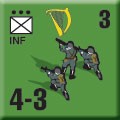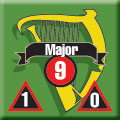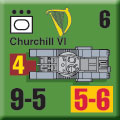Fighting Irish:
Invading Ireland
by Mike Bennighof, Ph.D.
March 2024
 During the summer of 1940, German staff officers attached to Army Group B began drafting detailed plans for an invasion of Ireland, known as Operation Green (not to be confused with Case Green, the planned 1938 invasion of Czechoslovakia). Two divisions would conduct the initial landings by sea, followed by three more plus attached artillery units, Brandenburg commandos and a separate motorized infantry battalion. During the summer of 1940, German staff officers attached to Army Group B began drafting detailed plans for an invasion of Ireland, known as Operation Green (not to be confused with Case Green, the planned 1938 invasion of Czechoslovakia). Two divisions would conduct the initial landings by sea, followed by three more plus attached artillery units, Brandenburg commandos and a separate motorized infantry battalion.
The operation would be commanded by Gen. Leonhard Kaupisch, formerly the head of occupation troops in Denmark. It would be launched as a subsidiary to Operation Sea Lion, the invasion of England, with the goal of drawing away British reserves from the main effort. About 50,000 troops would be involved, though not all of them would embark with the first wave.
Landings would take place on Ireland’s southeastern coast near Waterford, coincidentally the landing place of the Viking invasion of 853 and the English invasion of 1171. Kaupisch’s officers were allowed to requisition steamers from the French ports of Lorient, St. Nazaire and Nantes to carry the invasion force and after scouring the harbors found exactly two ships capable of carrying troops, plus three small coastal craft they thought might make it across the Celtic Sea (known in the U.K. as the Western Approaches). All others had already been scooped up for the higher-priority invasion of England.

The Irish Army on the march.
Even if the Germans were serious about invading Ireland – and despite the detailed planning and acquisition of accurate maps, there’s a good deal of suspicion among historians that the plan was simply disinformation – it would have been nearly impossible to execute with the resources at hand.
Nevertheless, the British made plans to intervene as though the German threat were very real indeed, and pressed the Irish to cooperate. The Irish finally agreed that if German troops landed in the Republic, the British garrison of Northern Ireland – the 53rd and 61st Divisions – would cross into the South to help the Irish resist them. A small brigade of Royal Marines would land at Wexford as well. The Irish would provide supplies and rail transport for the British forces.
 The Irish would also make available airfields for at least five Royal Air Force squadrons, and clear the rail lines heading south for British troop and munitions trains. Contingency orders prepared for the intervention noted that while the British forces would not enter the Republic without an invitation from the Irish government, some Irish could be expected to treat them as hostile invaders and offer armed resistance – including, possibly, the para-military Irish volunteer Local Security Force. The Irish would also make available airfields for at least five Royal Air Force squadrons, and clear the rail lines heading south for British troop and munitions trains. Contingency orders prepared for the intervention noted that while the British forces would not enter the Republic without an invitation from the Irish government, some Irish could be expected to treat them as hostile invaders and offer armed resistance – including, possibly, the para-military Irish volunteer Local Security Force.
Under the Anglo-Irish Treaty of 1921 that brought Ireland her independence, Britain had retained usage rights to three ports: Lough Swilly on the northern coast, Queenstown on the southeastern coast and Berehaven on the southwestern shore. All had played important roles as naval bases during the First World War, and retained their garrisons and coastal defenses under the new arrangement.
During the 1930’s, Ireland and the United Kingdom had waged a bitter trade war, sparked by Ireland’s refusal to continue payments for what the Irish considered excessive British rents during the 19th Century. The Irish considered the payments a public debt as they were made between governments, and therefore cancelled by the 1921 treaty. The British insisted these debts were exempt from the treaty since the money had gone to reimburse private landlords. The Irish public launched a furious boycott, vowing to “burn everything English except their coal.”
 Britain and Ireland finally settled their dispute in 1938, with the Irish making a lump-sum payment to settle the rent dispute and the British returning the three ports to Irish control and removing their garrisons. Winston Churchill, then a Member of Parliament, protested vigorously. “But what guarantee have you,” he raged, “that Southern Ireland, or the Irish Republic, as they claim to be and you do not contradict them will not declare neutrality if we are engaged in war with some powerful nation?” Britain and Ireland finally settled their dispute in 1938, with the Irish making a lump-sum payment to settle the rent dispute and the British returning the three ports to Irish control and removing their garrisons. Winston Churchill, then a Member of Parliament, protested vigorously. “But what guarantee have you,” he raged, “that Southern Ireland, or the Irish Republic, as they claim to be and you do not contradict them will not declare neutrality if we are engaged in war with some powerful nation?”
And so two years later Churchill, now Prime Minister, directed that if invited into Ireland the British forces should first seize the three ports, and only then eject the Germans. Churchill did not intend to let a crisis go to waste.
While the Germans did not plan extensive airborne operations as part of their Operation Green, the Anglo-Irish defense plans held that an invasion would likely be heralded by such landings. Drawing on the lessons of the just-concluded campaign in Norway, the British pointed out to the Irish the innovative German use of seaplanes as troop carriers, landing on lakes to disgorge their troops. Parachute attacks could be expected as well.
The British and Irish never settled the issue of command, and apparently intended to operate separately in the initial stages of the invasion. The Irish government could not place its troops under the command of the hated English short of dire emergency, while the British for their part could not reveal their own plans to grab the Treaty Ports.

Irish anti-aircraft defenses.
Thus the initial resistance to a German assault would be met by purely Irish forces. The Irish prepared as best they could to meet the expected airborne assault with mobile columns that marched quickly to the site of the landing – the Irish had no motorized forces. The Waterford area initially came under the watch of the 1st Brigade, with the independent Fifth Brigade taking over in the early autumn of 1940 when 1st Brigade was expanded to division status and shifted its coverage area to the southwest.
The Irish would not have to do much to thwart a German invasion: keeping them from Dublin and any major airfields for only a few days would allow enough time for British troops to arrive by rail. Germany did not have the excess air power to conduct an interdiction campaign north of the landing zone, and barring the cooperation of the Irish Republican Army to delay the British – something for which the Germans made no preparations – the airheads or beachheads would inevitably be crushed. And then the Irish would face the sticky question of asking her saviors to leave.
You can download Fighting Irish right here.
It’s $5.99, but if you’re a Gold Club member, it’s free to you as part of the Golden Library (there’s no Gold Club discount or freeness through Wargame Vault).
Click here to join the Gold Club
See your Gold Club Insider newsletter for ordering information.
Golden Chipboard
 Ten (10) chipboard sheets, slightly thicker than the ones we use for game pieces, for use in pasting up your own counters from our downloadable games and expansions. Ten (10) chipboard sheets, slightly thicker than the ones we use for game pieces, for use in pasting up your own counters from our downloadable games and expansions.
Order Golden Chipboard Here.
Order sticky label paper here.
Sign up for our newsletter right here. Your info will never be sold or transferred; we'll just use it to update you on new games and new offers.
Mike Bennighof is president of Avalanche Press and holds a doctorate in history from Emory University. A Fulbright Scholar and NASA Journalist in Space finalist, he has published a great many books, games and articles on historical subjects; people are saying that some of them are actually good.
He lives in Birmingham, Alabama with his wife, three children, and new puppy. He misses his lizard-hunting Iron Dog, Leopold.
Daily Content includes no AI-generated content or third-party ads. We work hard to keep it that way, and that’s a lot of work. You can help us keep things that way with your gift through this link right here.
|
